
KAREN WILKIN
291
always, Frankenthaler's acute intuition, intelligence, and all-out passion
for both the act and the tradition of painting were manifest.
Other types of intuition, intelligence, and passion were also manifest
at the much-touted Cecily Brown's show at Gagosian in Soho-Brown
has been much-touted, not the show- along the lines of instinct for
marketing, canniness about current art modes, and appetite for self–
promotion. Brown paints immense webs of arbitrary, nervous, layered
strokes that vaguely intimate images of sexual organs and figures. These
latent configurations seem to interest her, but most of what happens on
her huge canvases seems to be dogged, mechanical filling-in. Nothing
that goes on within any of the pictures suggests any compelling reason
for it to be the size, shape, or proportion that it is; color is predictable
and surfaces slack. Brown appears to have looked at de Kooning repro–
ductions, but not hard enough. For all the hype, the self-conscious
naughtiness, and the self-importance of her pictures, she is a dull painter.
You 'd have done better, while in Soho, to visit Richard Tuttle's show
of recent works at Sperone Westwater. Cryptically titled
Two With Any
To,
the exhibition consisted of "relief paintings" on plywood panels
about twelve inches square. Each square pitted idiosyncratic, delicately
scaled painted shapes against applied geometric solids, their various
faces subverted by hues as quirky as the shapes. These intimate little
constructed pictures blurred the distinctions between illusion and fact,
painting and relief, invention and actuality. Each one set up a seemingly
straightforward but complex dialogue between flat surface and bulk,
painting gesture and real form, with the added complication of the real
form's having been altered by painting gestures and changes in hue. The
insistent presence of the plywood not only worked in terms of color, but
also served to return you to the realm of physical object whenever you
became too engaged by pictorial subtleties. Tuttle's provocative, slightly
uncanny works demanded-and repaid--dose attention. Their author
has been a quiet presence for thirty years; the soft-spoken authority of
these recent pictures was evidence that he continues to evolve and grow.
Like Tuttle, David Humphrey is fascinated by the tension between
what is literally present in a picture, what you are conditioned to read
as illusion, and an ineffable zone somewhere between the two. His
firmly constructed, but unstable images, seen at McKee Gallery, depend
on layers of elegantly drawn and painted fragments, each with its own
scale, viewpoint, and often, painting language, all presented in delicate
marzipan colors. Equivocal bits of heads, hands, and voluptuous torsos
pulse in and out of each other, changing scales and relationships, as
though these static configurations were morphing into different spatial


